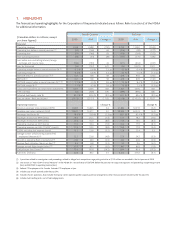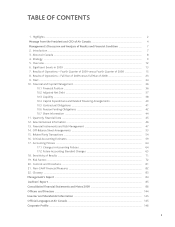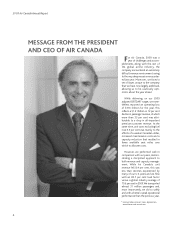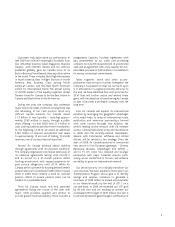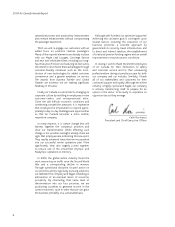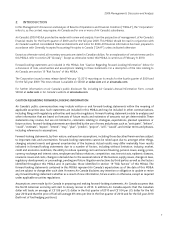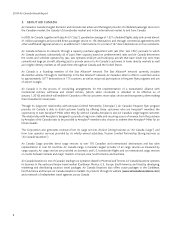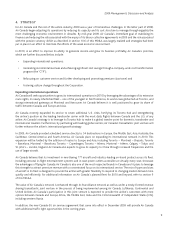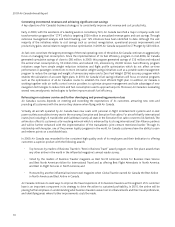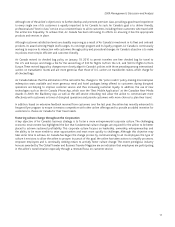Air Canada 2009 Annual Report Download - page 5
Download and view the complete annual report
Please find page 5 of the 2009 Air Canada annual report below. You can navigate through the pages in the report by either clicking on the pages listed below, or by using the keyword search tool below to find specific information within the annual report.5
Customers truly appreciated our performance. In
late 2009 we received meaningful accolades from
two infl uential business travel magazines. Business
Traveler, with 500,000 readers and ten editions
published globally, gave Air Canada more of its
Best in Business Travel Awards than any other airline
in the world. These included: Best Flight Attendants
in North America; Best In-fl ight Services in North
America; Best Business Class among North
American carriers; and the Best North American
Airline for International Travel. The annual survey
of 25,000 readers of the equally respected Global
Traveler found Air Canada to be the Best Airline in
Canada and Best Airline in North America.
During the year, the company also addressed
major structural issues. Foremost among these was
the rebuilding of our cash position amid very
difficult capital markets. Air Canada raised
$1.3 billion in new liquidity – including approxi-
mately $260 million in equity through a public
share offering – to end 2009 with $1.4 billion in
cash, cash equivalents and short term investments.
At the beginning of 2010, we raised an additional
$100 million to improve unrestricted cash levels
to approximately 15 per cent of trailing 12 month
revenues, one of our key financial objectives.
Second, Air Canada attained labour stability
through agreements with its unionized workforce.
The company negotiated cost neutral extensions of
its collective agreements lasting until mid-2011
and an accord on a 21-month pension deficit
funding moratorium, with capped payments for
past service obligations until 2014. While Air
Canada aims to preserve its existing defined benefit
pension plans and contributed $389 million toward
them in 2009, there remains a need for national
pension reform to ensure pension plans can be
funded on a sustainable basis.
Third, Air Canada struck new and amended
agreements during the course of the year with
major credit providers, suppliers and vendors to
provide greater financial stability. These included a
renegotiated Capacity Purchase Agreement with
Jazz, amendments to our credit card processing
contracts to revise the required levels of un restricted
cash, and an agreement with a key supplier for non-
refundable proceeds of $230 million in consi deration
for various contractual commitments.
Taken together, these and other accom-
plishments have served to further strengthen the
company’s foundation so that we can build upon
it in anticipation of a general industry rebound. To
this end, we have identified four main priorities for
2010 that will further secure and extend these
gains, with the objective of transforming Air Canada
so that it becomes a profitable company over the
long term.
First, Air Canada will expand its international
presence by leveraging the geographic advantages
of its major hubs, its array of international route
authorities and extensive partnerships formed
with other carriers through Star Alliance, the
world’s leading airline network with 26 member
carriers. Continental Airlines’ entry into Star Alliance
in 2009 and the recently-created transatlantic
alliance with Continental, Lufthansa and United
Airlines will be central to this strategy. Since the
start of 2009, Air Canada launched or announced
new service to five European gateways – Geneva,
Barcelona, Brussels, Copenhagen and Athens –
and to 15 U.S. cities. Our renewed and stronger
partnership with major Canadian airports, parti-
cularly at our central hub in Toronto, will enhance
our ability to grow our international network.
Our second priority is to radically transform our
cost structure. We have adopted a three-year Cost
Transformation Program whose goal is to identify
savings and revenue initiatives to generate a
minimum of $500 million in annual improvements
to our financial results by the end of 2011, on a
run-rate basis. In 2009 we exceeded our CTP goal
by 40 per cent and are tracking to achieve our
accelerated 2010 target of $270 million. Our aim is
to achieve permanent gains though a combination of


